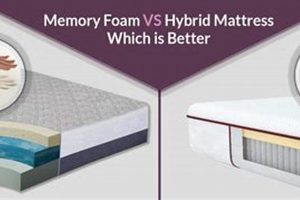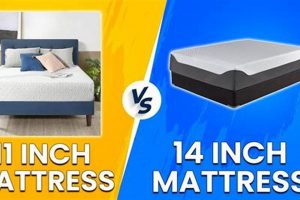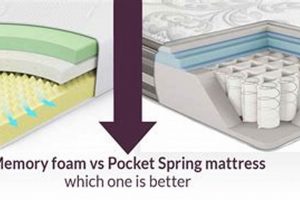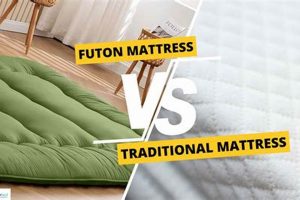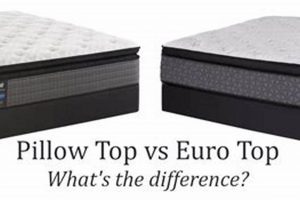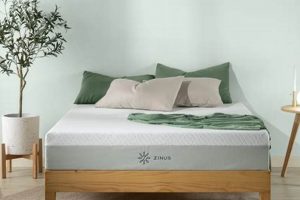The selection of a mattress frequently involves choosing between two primary construction types: those utilizing an innerspring system for support and those relying on various foam compositions. Each type offers a distinct feel and performance profile, catering to different sleep preferences and needs. One relies on coil technology, while the other employs materials like memory foam or latex for its core structure.
The implications of selecting the right mattress are significant, impacting sleep quality, spinal alignment, and overall well-being. Historically, innerspring models were the standard, but advancements in foam technology have broadened the market and provided alternative solutions for pressure relief and motion isolation. The evolution of mattress design reflects a growing understanding of sleep science and individual comfort requirements.
The following sections will delve into the specific characteristics of each mattress type, examining factors such as support, durability, temperature regulation, and cost. This comparison aims to provide consumers with the information needed to make an informed decision based on their individual circumstances and priorities. Key differences in construction and their subsequent effects on sleep quality will be thoroughly explored.
Selecting an appropriate mattress requires careful consideration of individual needs and preferences. The following tips aim to provide guidance when evaluating options, focusing on the core attributes of each type.
Tip 1: Assess Sleep Position: Side sleepers generally benefit from the enhanced pressure relief offered by foam, while back and stomach sleepers often find the firmer support of an innerspring model more suitable. Observe your natural sleep posture to inform your selection.
Tip 2: Consider Body Weight: Individuals with higher body weights may require the increased support and resilience provided by an innerspring system to prevent excessive sinking and maintain spinal alignment. Foam density plays a crucial role for heavier individuals selecting a foam mattress.
Tip 3: Evaluate Temperature Sensitivity: Foam mattresses, particularly memory foam, can retain heat. If overheating is a concern, explore innerspring models with enhanced airflow or foam options incorporating cooling technologies like gel infusions.
Tip 4: Analyze Motion Transfer: Foam mattresses excel at isolating motion, making them ideal for couples where one partner is easily disturbed by the other’s movements. Innerspring mattresses tend to transmit motion more readily.
Tip 5: Investigate Durability Expectations: Innerspring mattresses typically have a shorter lifespan than high-density foam options. Consider the long-term cost and replacement frequency when making your decision.
Tip 6: Examine Edge Support: Strong edge support is crucial for preventing roll-off and maximizing usable sleep surface. Innerspring mattresses often have reinforced edges, while some foam models may lack adequate support along the perimeter.
Tip 7: Understand Budget Constraints: Mattress prices vary significantly. Establish a budget beforehand and compare options within that range, focusing on value and long-term performance rather than simply the lowest price.
By carefully considering these factors, individuals can improve their chances of selecting a mattress that aligns with their specific needs and contributes to improved sleep quality. Prioritizing these considerations ensures a well-informed decision.
The subsequent sections will delve deeper into specific material compositions and construction techniques, offering a more granular understanding of the options available.
1. Support
Support, in the context of mattress selection, refers to the ability of the mattress to maintain proper spinal alignment and distribute body weight evenly. This is a crucial factor differentiating innerspring and foam mattress designs. An innerspring mattress achieves support through its coil system, with varying coil gauges and configurations influencing the firmness and responsiveness. A firmer coil system generally provides more robust support for heavier individuals or those who prefer sleeping on their stomach. Conversely, a foam mattress relies on the density and composition of its foam layers to provide support. High-density foam offers greater resistance to compression, thereby providing enhanced support. An individual with lower back pain, for example, might find relief from a mattress that offers sufficient support to prevent spinal misalignment, highlighting the direct impact of support on physical well-being.
The type of support offered directly affects sleep quality and physical health. Inadequate support can lead to pressure points, muscle strain, and chronic pain. For example, a side sleeper on an insufficiently supportive mattress may experience pressure buildup on the shoulder and hip, disrupting sleep and potentially leading to discomfort. Different foam types provide varying levels of support. Memory foam conforms closely to the body, providing localized support and pressure relief. Latex foam offers a more resilient and responsive support, pushing back against the body to prevent sinking. Innerspring mattresses with zoned support systems, where the coil density varies across different areas of the mattress, attempt to provide targeted support to different regions of the body. The effectiveness of support systems will change overtime as the materials degrades.
Understanding the relationship between support and mattress construction is essential for making an informed purchase. The selection should align with individual sleep preferences, body weight, and any existing physical conditions. It is not merely about firmness or softness; it is about ensuring that the spine maintains its natural curvature throughout the night. Ignoring this critical aspect can lead to long-term discomfort and potentially exacerbate existing health problems. Ultimately, prioritizing support is an investment in overall health and well-being. The challenge lies in identifying the support system that best caters to individual needs, necessitating thorough research and potentially, in-store testing.
2. Durability
Durability, in the context of mattress selection, refers to the lifespan and resistance to wear and tear of a mattress over time. It is a critical consideration when comparing innerspring and foam mattress options, as it directly impacts the long-term value and overall cost-effectiveness of the purchase.
- Coil Fatigue in Innerspring Mattresses
Innerspring mattress durability is significantly influenced by the quality and gauge of the coils. Lower-gauge coils, while offering initial comfort, are prone to fatigue and loss of support over time, leading to sagging and unevenness. The number of turns in a coil also impacts durability; more turns generally indicate greater resilience. For example, a mattress used nightly by a heavier individual with low-quality coils may exhibit noticeable sagging within a few years, compromising sleep quality and necessitating premature replacement.
- Foam Density and Degradation in Foam Mattresses
Foam mattress durability is largely dependent on the density of the foam layers. High-density foams, such as those found in quality memory foam and latex mattresses, are more resistant to compression and retain their shape and support for a longer period. Low-density foams, often used in cheaper models, are susceptible to degradation, resulting in indentations and a loss of overall support. For instance, a mattress with a low-density memory foam comfort layer might develop body impressions within a short period, reducing its comfort and support capabilities.
- Material Composition and Resistance to Environmental Factors
The materials used in both innerspring and foam mattresses can affect their resistance to environmental factors, such as humidity and temperature fluctuations. Some foam types are more prone to moisture retention, which can lead to mold growth and premature degradation. Similarly, innerspring mattresses with inadequate ventilation may experience rust and corrosion of the coils over time. For example, a mattress exposed to high humidity levels in a poorly ventilated bedroom could experience accelerated wear and tear, regardless of its initial quality.
- Construction Techniques and Overall Longevity
The construction techniques employed in manufacturing a mattress also play a significant role in its overall durability. Mattresses with reinforced edges, robust stitching, and high-quality adhesives are generally more resistant to wear and tear. Conversely, mattresses with weak seams, low-quality adhesives, or poorly designed support systems are more likely to experience premature failure. As an example, a mattress with a poorly attached pillow top might separate from the main support structure within a few years, significantly reducing its lifespan.
In comparing durability across mattress types, it’s crucial to consider the specific materials and construction methods employed. While high-quality foam mattresses may offer superior longevity compared to lower-end innerspring models, well-constructed innerspring mattresses with durable coils and reinforced support systems can also provide a long-lasting sleep solution. Ultimately, careful evaluation of material quality, construction techniques, and individual usage patterns is essential for maximizing the lifespan of any mattress.
3. Pressure Relief
Pressure relief, in the context of mattress selection, refers to the mattress’s capacity to alleviate stress on specific areas of the body during sleep. This feature is particularly relevant when considering spring versus foam mattress construction, as each type offers distinct pressure-relieving properties. Foam mattresses, especially those utilizing memory foam or latex, tend to conform to the body’s contours, distributing weight more evenly and reducing pressure points. This conformity minimizes stress on areas such as the hips, shoulders, and spine. In contrast, spring mattresses, while providing support, may not offer the same level of pressure relief due to their more rigid structure. Individuals with conditions such as arthritis or fibromyalgia, where pressure sensitivity is heightened, often find greater comfort and pain reduction with foam mattresses. The effectiveness of pressure relief directly influences sleep quality and overall physical well-being.
The mechanism behind pressure relief differs significantly between mattress types. Memory foam achieves its pressure-relieving qualities through viscoelasticity, allowing it to mold to the sleeper’s shape and redistribute weight. Latex foam, while also conforming, offers a more buoyant feel, providing pressure relief with greater responsiveness. Spring mattresses, on the other hand, rely on the compression of coils to provide support, which may not always effectively alleviate pressure points. Hybrid mattresses, which combine spring and foam elements, attempt to balance support and pressure relief, but the specific configuration and material quality determine their effectiveness. For example, a hybrid mattress with a thick memory foam comfort layer may offer substantial pressure relief, while one with a thin layer may not provide significant benefit. Individual experiences vary, and factors such as body weight and sleep position influence the perceived pressure relief.
Ultimately, the significance of pressure relief in mattress selection lies in its impact on sleep quality and pain management. Individuals seeking to minimize pressure points and enhance comfort often prioritize foam mattresses for their contouring properties. However, the choice between spring and foam depends on a comprehensive evaluation of individual needs, considering factors such as support, temperature regulation, and personal preferences. Understanding the mechanisms through which each mattress type provides pressure relief is crucial for making an informed decision that promotes restful sleep and reduces physical discomfort. Neglecting pressure relief can lead to disrupted sleep, increased pain, and a reduced overall quality of life.
4. Motion Isolation
Motion isolation, defined as a mattress’s ability to minimize the transfer of movement across its surface, is a critical attribute for couples or individuals sharing a bed. The performance in this area varies significantly between innerspring and foam mattress types, influencing sleep disturbance and overall comfort.
- Coil Design and Motion Transfer in Innerspring Mattresses
Traditional innerspring mattresses, characterized by interconnected coils, tend to exhibit higher motion transfer. When one partner moves, the connected coil system transmits the movement across the mattress surface, potentially disturbing the other partner’s sleep. Pocketed coil systems, where individual coils are encased in fabric pockets, offer improved motion isolation compared to traditional innerspring designs. However, even with pocketed coils, the inherent springiness of the system can still result in some degree of motion transfer. A scenario where one partner frequently tosses and turns on a traditional innerspring mattress highlights the disruptive potential of high motion transfer.
- Foam Density and Motion Absorption in Foam Mattresses
Foam mattresses, particularly those constructed with memory foam or latex, excel at motion isolation due to their ability to absorb and dissipate movement. The dense, viscoelastic properties of these materials prevent motion from propagating across the mattress surface. When one partner moves on a foam mattress, the motion is primarily contained to the immediate area, minimizing disturbance to the other partner. A common example involves a couple where one partner works different shifts; the motion isolation of a foam mattress allows the other partner to sleep undisturbed during shift changes.
- Hybrid Construction and Motion Isolation Compromises
Hybrid mattresses, which combine innerspring and foam components, present a compromise in motion isolation. The foam layers, typically located in the comfort layer, contribute to motion absorption, while the innerspring system provides support. The degree of motion isolation in a hybrid mattress depends on the thickness and density of the foam layers, as well as the type of coil system used. A hybrid mattress with a thick memory foam comfort layer and pocketed coils may offer good motion isolation, while one with a thin foam layer and interconnected coils may exhibit higher motion transfer.
- Edge Support and its Impact on Motion Isolation
While not directly related to the core motion isolation properties, edge support can indirectly influence the perceived transfer of movement. Mattresses with weak edge support may cause individuals to roll towards the edge, potentially disturbing a sleeping partner. Foam mattresses generally offer less edge support compared to innerspring mattresses with reinforced edges. Selecting a foam mattress with reinforced edges or a hybrid model with strong edge support can mitigate this issue. Consider an instance where a person sleeping near the edge of a mattress with poor edge support tends to roll, inadvertently disturbing their partner, this is the impact of edge support on motion isolation.
In conclusion, the choice between innerspring and foam mattresses hinges on the relative importance of motion isolation. For couples prioritizing undisturbed sleep, foam mattresses generally offer superior motion isolation capabilities. However, hybrid mattresses with carefully selected components can provide a reasonable compromise between support and motion isolation. Evaluating these factors in relation to individual sleep needs and preferences is essential for making an informed mattress selection.
5. Temperature
Temperature regulation is a critical factor influencing sleep comfort. The selection of a mattress type, specifically between innerspring and foam constructions, can significantly impact the sleep environment’s thermal properties. The materials used in mattress construction inherently possess varying degrees of heat retention and dissipation capabilities, affecting the sleeper’s thermal experience.
- Airflow and Innerspring Systems
Innerspring mattresses typically offer superior airflow compared to their foam counterparts. The open structure of the coil system allows for greater air circulation, facilitating heat dissipation and reducing the likelihood of overheating. This characteristic is particularly beneficial for individuals who tend to sleep hot or reside in warmer climates. The increased airflow promotes a cooler sleep surface, enhancing comfort and minimizing sleep disruptions caused by thermal discomfort. The breathability is often a deciding factor.
- Heat Retention in Foam Materials
Foam mattresses, particularly those made with memory foam, are known for their potential to retain heat. The dense structure of memory foam limits airflow, which can trap body heat and lead to a warmer sleep environment. While some manufacturers incorporate cooling technologies, such as gel infusions or open-cell foam structures, these modifications may not completely eliminate the heat retention issue. The degree of heat retention depends on the foam’s density and composition. High-density memory foam tends to retain more heat than lower-density options. The amount of heat retained during sleep disrupts the sleep pattern.
- Material Composition and Thermal Conductivity
The thermal conductivity of the materials used in mattress construction significantly impacts temperature regulation. Materials with higher thermal conductivity, such as latex foam or certain types of gel-infused memory foam, are more effective at dissipating heat away from the body. Conversely, materials with lower thermal conductivity, such as traditional memory foam, tend to retain heat. The choice of materials directly influences the overall thermal performance of the mattress. Therefore, consider the composition of the mattress and its conductive properties to find the correct balance.
- Environmental Factors and Climate Considerations
The impact of temperature regulation on sleep comfort is influenced by environmental factors, such as room temperature and humidity levels. In warmer climates, the heat retention properties of foam mattresses may be more pronounced, leading to increased discomfort. Conversely, in cooler climates, the insulating properties of foam mattresses may be desirable, providing a warmer and more comfortable sleep environment. Consider these environmental aspects when selecting the best option.
The choice between innerspring and foam mattresses regarding temperature regulation hinges on individual thermal preferences and environmental conditions. Individuals who tend to sleep hot or reside in warmer climates may benefit from the superior airflow of innerspring mattresses. Conversely, those who prefer a warmer sleep environment or live in cooler climates may find foam mattresses more suitable. Understanding these nuances is crucial for selecting a mattress that promotes comfortable and restful sleep.
6. Cost
The financial outlay required for a mattress represents a significant consumer consideration. Price points vary considerably between innerspring and foam models, influenced by materials, construction complexity, and brand reputation. A thorough understanding of cost factors is crucial for aligning budgetary constraints with desired features and performance.
- Initial Purchase Price
Generally, innerspring mattresses tend to have a lower entry-level price point compared to foam mattresses. Basic innerspring models utilizing simpler coil systems and less-expensive comfort layers can be more accessible for budget-conscious consumers. Conversely, foam mattresses, particularly those incorporating advanced materials like memory foam or latex, often command a higher initial investment due to manufacturing processes and material costs. For example, a queen-size innerspring mattress might start at $300, while a comparable memory foam mattress could begin around $500. These starting values vary from brand to brand and sales events.
- Material Composition and Pricing
The composition of the mattress core and comfort layers significantly impacts the price. High-density foams, specialty coil systems (such as individually wrapped coils), and natural materials like organic cotton or wool contribute to increased manufacturing expenses, which are subsequently reflected in the retail price. Innerspring mattresses with complex zoned coil systems or enhanced edge support features typically cost more than basic models. Similarly, foam mattresses utilizing multiple layers of different foam types or incorporating cooling technologies will generally be priced higher. As an example, a latex mattress with a Dunlop latex core can be more expensive than a traditional polyurethane foam.
- Longevity and Long-Term Cost
While the initial purchase price is a primary concern, the long-term cost of ownership must also be considered. A less expensive mattress that deteriorates rapidly may require premature replacement, ultimately exceeding the total cost of a more durable, albeit initially more expensive, option. High-quality foam mattresses, particularly those with high-density foam cores, often exhibit greater longevity than basic innerspring models, potentially offsetting their higher initial price over time. Regular flipping and rotating mattresses can assist longevity regardless of material.
- Warranty Coverage and Brand Reputation
The extent of warranty coverage and the manufacturer’s reputation can indirectly influence the perceived value and overall cost of a mattress. A mattress with a longer warranty period offers greater protection against defects and premature degradation, reducing the risk of unexpected replacement costs. Established brands with a history of producing high-quality, durable mattresses often command premium prices, reflecting consumer confidence in their products. Reading online reviews and considering warranty details can provide valuable insights into the long-term cost implications of a mattress purchase. In addition, reading over warranty paperwork ahead of time will give you a head start.
In conclusion, the cost of a mattress extends beyond the initial purchase price. A comprehensive evaluation should incorporate factors such as material composition, expected lifespan, warranty coverage, and brand reputation. Understanding these nuances enables consumers to make informed decisions that align with their budgetary constraints and desired level of performance, ensuring optimal value and long-term satisfaction.
Frequently Asked Questions
The following section addresses common inquiries concerning the selection between spring and foam mattresses, providing factual and unbiased information to aid in informed decision-making.
Question 1: What are the primary distinctions in construction between spring and foam mattresses?
Spring mattresses utilize a core of metal coils for support, often supplemented by comfort layers of padding or foam. Foam mattresses, conversely, employ various foam types, such as memory foam, latex, or polyurethane foam, as their primary support and comfort components.
Question 2: Which mattress type is generally more suitable for individuals with back pain?
The suitability of a mattress for back pain depends on individual preferences and spinal alignment needs. Foam mattresses, particularly those with memory foam, can offer enhanced pressure relief and contouring, which may benefit some individuals. Spring mattresses, if providing adequate support, can also be suitable. Consultation with a medical professional is recommended.
Question 3: Does one mattress type inherently offer superior durability compared to the other?
Durability varies depending on the quality of materials and construction techniques. High-density foam mattresses often exhibit greater longevity than lower-end spring mattresses. However, well-constructed spring mattresses with durable coil systems can also provide long-lasting support. Material composition and expected usage should be assessed.
Question 4: How does temperature regulation differ between spring and foam mattresses?
Spring mattresses generally offer better airflow due to their open coil structure, promoting heat dissipation. Foam mattresses, particularly memory foam, can retain heat. However, some foam mattresses incorporate cooling technologies to mitigate heat retention. Environmental factors and individual sleep preferences influence temperature comfort.
Question 5: Which mattress type provides better motion isolation for couples?
Foam mattresses, particularly those made with memory foam, typically offer superior motion isolation compared to spring mattresses. The dense foam absorbs and dissipates movement, minimizing disturbance to a sleeping partner. Spring mattresses, especially those with interconnected coils, tend to transmit motion more readily.
Question 6: What are the typical price ranges for spring and foam mattresses?
Spring mattresses generally have a lower entry-level price point compared to foam mattresses. However, prices vary significantly depending on materials, construction, and brand. Advanced spring mattresses with zoned coil systems can approach the cost of mid-range foam mattresses. Budgetary constraints should be considered in conjunction with desired features.
In summary, selecting a mattress involves evaluating individual needs and preferences in relation to support, durability, pressure relief, motion isolation, temperature regulation, and cost. No single mattress type is universally superior; the optimal choice depends on a comprehensive assessment of personal requirements.
The subsequent section will offer a comparative analysis of hybrid mattress options, bridging the gap between traditional spring and foam constructions.
Spring Mattress vs. Foam Mattress
The preceding analysis has explored the core distinctions between spring and foam mattress constructions, encompassing considerations of support, durability, pressure relief, motion isolation, temperature regulation, and cost. Each mattress type presents inherent advantages and disadvantages, contingent upon individual needs and preferences. No definitive superior option exists; rather, optimal selection necessitates a thorough evaluation of personal requirements aligned with the characteristics of each mattress category. The properties and materials of each construction should be the guiding factors during the decision-making process.
The information provided serves to empower consumers to make informed choices, recognizing the significant impact of mattress selection on sleep quality and overall well-being. Continued advancements in mattress technology will likely yield hybrid designs that further blur the lines between traditional spring and foam constructions, offering an even greater spectrum of options. Ongoing research and diligent product assessment remain crucial for navigating the evolving landscape of sleep solutions and optimizing the sleep experience.


